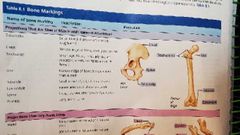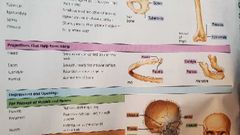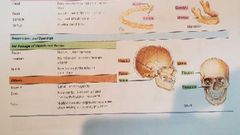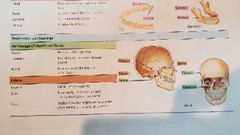![]()
![]()
![]()
Use LEFT and RIGHT arrow keys to navigate between flashcards;
Use UP and DOWN arrow keys to flip the card;
H to show hint;
A reads text to speech;
37 Cards in this Set
- Front
- Back
|
Skeleton |
Function: support and protect body •Levers for muscles •Lipid and mineral storage (Ca 2+) •Site of RBC formation |
|
|
Axial skeleton |
Bones of the head and trunk •Skull (cranial & facial bones) Auditory ossicles •Vertebral column •Throacic cage -sternum -ribs 24 |
|
|
Appendicular skeleton |
Limps and appendages
•Upper extremity •Pectoral girdle •Upper extremity•Pelvic girdle •Lower extremity •Pelvic girdle •Lower extremity |
|
|
Pectoral girdle (Appendicular skeleton) |
•Clavicle •Scapula |
|
|
Upper extremity (Appendicular skeleton) |
Humerus Radius Ulna Carpal 16 Metacarpals 10 Phalanges 28 |
|
|
Pelvic girdle (Appendicular skeleton) |
Illium Ischium Pubis
|
|
|
Lower extremity (appendicular skeleton) |
Femur Patella Tibia Fibula Tarsal 14 Metatarsal 10 Phalanges 28 |
|
|
Cranial bones (8 bones) |
•Enclose and protect brain tissue •joined together by sutures (interlocking fibrous joints) Parietal 2 Temporal 2 Frontal Occipital Ethmoid Sphenoid |
|
|
Facial bones (14 bones) 12 paired |
•Support the eyes and position them anteriorly •Attachment site for facial muscles •joined together by sutures (interlocking fibrous joints)
Maxilla Zygomatic Mandible (freely movable joint- not paired) Nasal Palatine Hyoid |
|
|
Auditory ossicles |
Malleus Incus Stapes |
|
|
Vertebral column |
Cervical 7 Thoracic 12 Lumbar 5 Sacrum Coccyx |
|
|
Throacic cage |
-sternum -ribs 24 |
|
|
Cartilage of skeleton |
Hyaline (most common,embryonic) Elastic (most flexible) Fibrocartilage (strength & shock absorption) |
|
|
Hyaline Cartilage (most common,embryonic) |
Articular - covers most bones at movable joints Costal- connects ribs to sternum Respiratory- found in larynx and other respiratory structures Nasal- support external nose |
|
|
Elastic cartilage (most flexible) flexible) |
External ear Epiglottis (guardian of the earway) |
|
|
Fibrocartilage (strength & shock absorption) |
Intervertebral disc's- pads between vertebrae Menisci- pads located at knees Public symphysis- located where hip bone join anteriorly |
|
|
Cartilage |
•No nerves or blood vessels •Surrounded by dense irregular connective tissue (perichondrium) |
|
|
# of Bones in the human body |
206 in total |
|
|
Osseous tissue |
Compact bones- dense made up of osteons Spongy Bone- composed of small trabecule columns. |
|
|
Bone classification |
Long Short Flat Irregular |
|
|
Long bones |
Composed of: compact bone Description: long shaft with heads on either end Ex. Femur, Phalanges Shaft=diaphysis End of long bone= epiphysis Perforating fibers= collagen fibers |
|
|
Short bones |
Composed of: more spongy bone than compact boneDescription: cube shapedEx. Tarsals and carpals |
|
|
Flat bones |
Composed of: compact bone with thick layers of spongy bone between themDescription: curvedEx. Bones of cranium |
|
|
Irregular bones |
Description: all other bonesEx. Vertebrae |
|
|
Sesamoid bones |
Description- short bones formed with tendons Ex. Patellas |
|
|
Sutural bones |
Tiny bones between cranial bones |
|
|
Bone markings |
Where bones form joints with other bones, where muscles, tendons, and ligaments were attached and where nerve and blood vessels passed. |
|
|
Projections for site of muscle and ligament attachment |

|
|
|
Projects that help for joints |

|
|
|
Depression and opening for nerve an d blood vessels |

|
|
|
Others |

|
|
|
Bone formation |
Occurs in all bones inferior to the skull except the collar bone Process called: endochondral ossifaction |
|
|
Endochondral ossifaction (Step 1) |
Blood vessels invade the perichondrium covering the hyalinr cartilage model and convert it to a periosteum |
|
|
Endochondral ossifaction (Step 2) |
OsteoblastS at the inner surface of the periosteum secrete bone matrix around the hyaline cartilage model forming a bone collar |
|
|
Endochondral ossifaction (Step 3) |
Cartilage in the shaft center calcifies and then hollows out forming an internal cavity |
|
|
Endochondral ossifaction (Step 4) |
A periosteal (blood vessels, nerves, redbone marrow, elements osteoblast, osteoclasts) invade the cavity and form spongy bone. which is removed by osteoclasts producing the medullary cavity. Proceeds in both directions from the primary ossifaction center. |
|
|
Endochondral ossifaction (Step 5) |
As bones grow medulla cavity gets larger and longer Chondroblasts lay down new cartilage matrix on epiphyseal face of the plate Which is eroded and replaced by bony spicules on diaphyseal face Continues until late adolescence until epiphyseal plate is replaced by bone |

